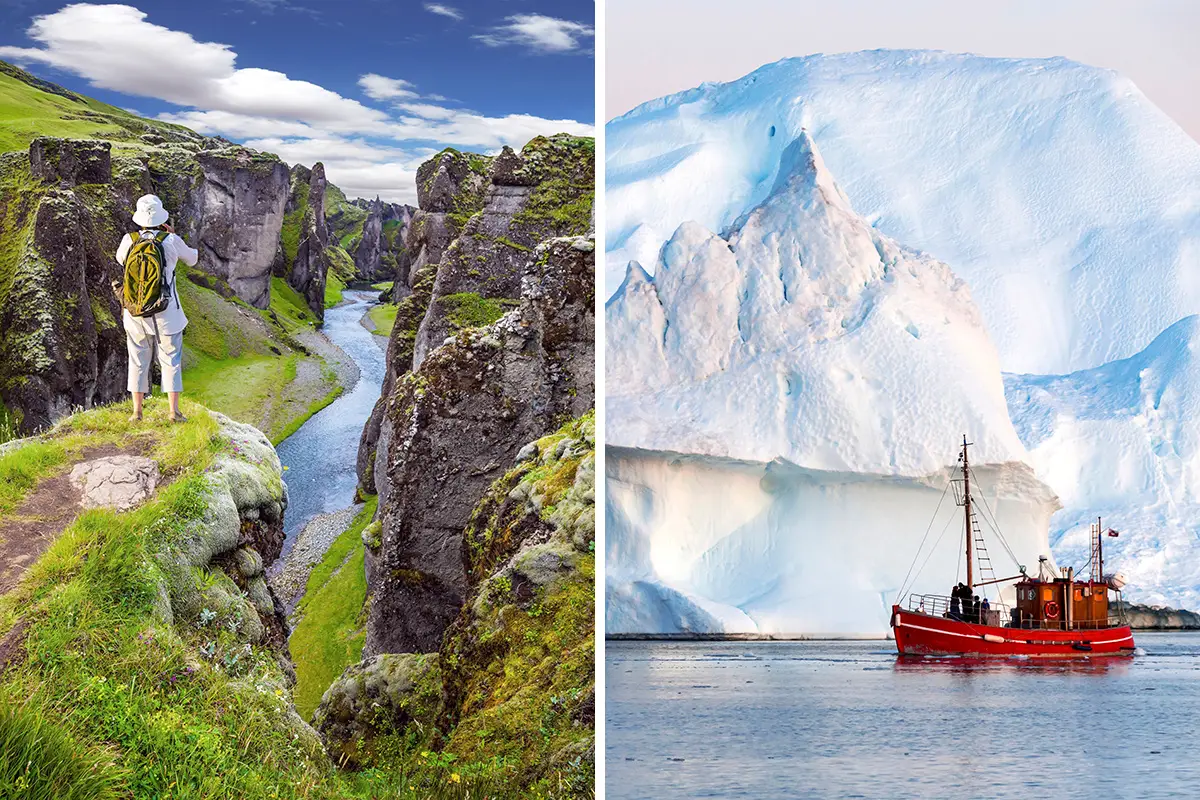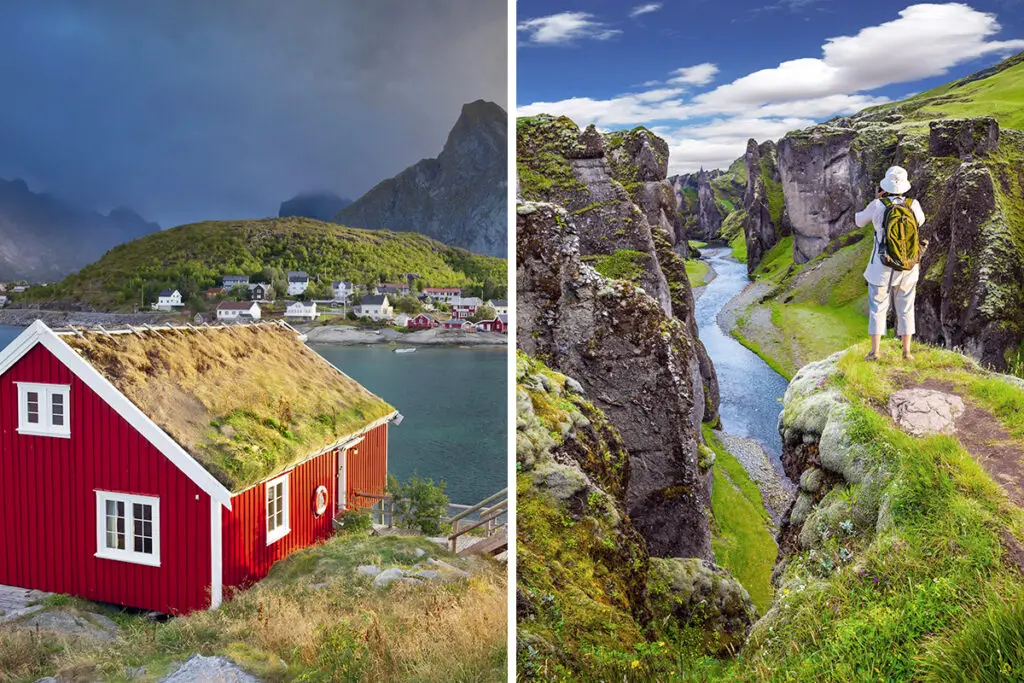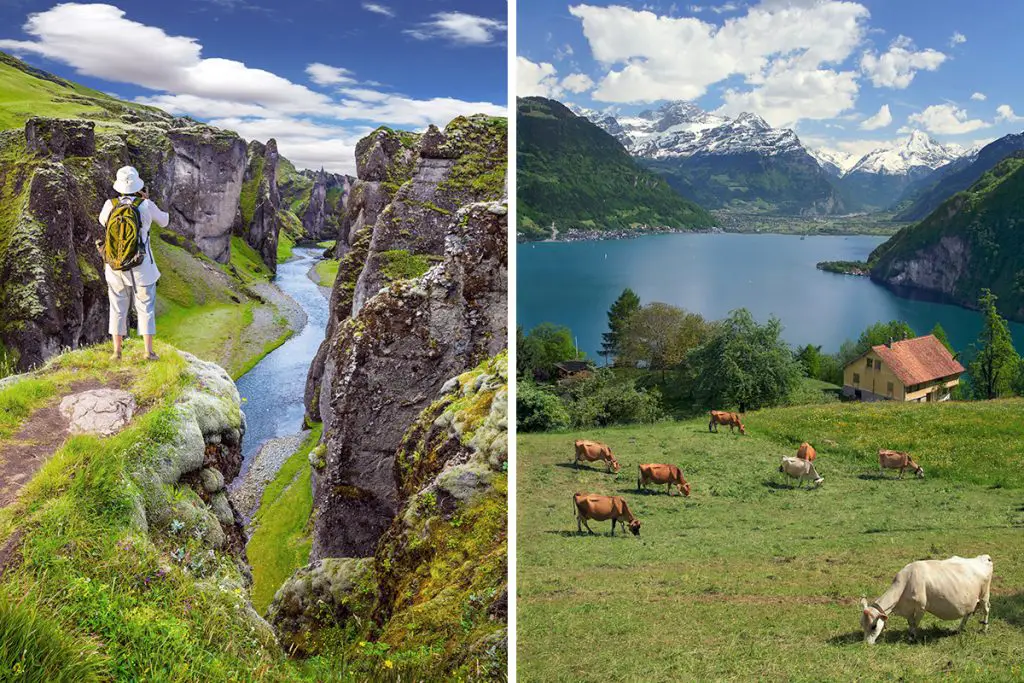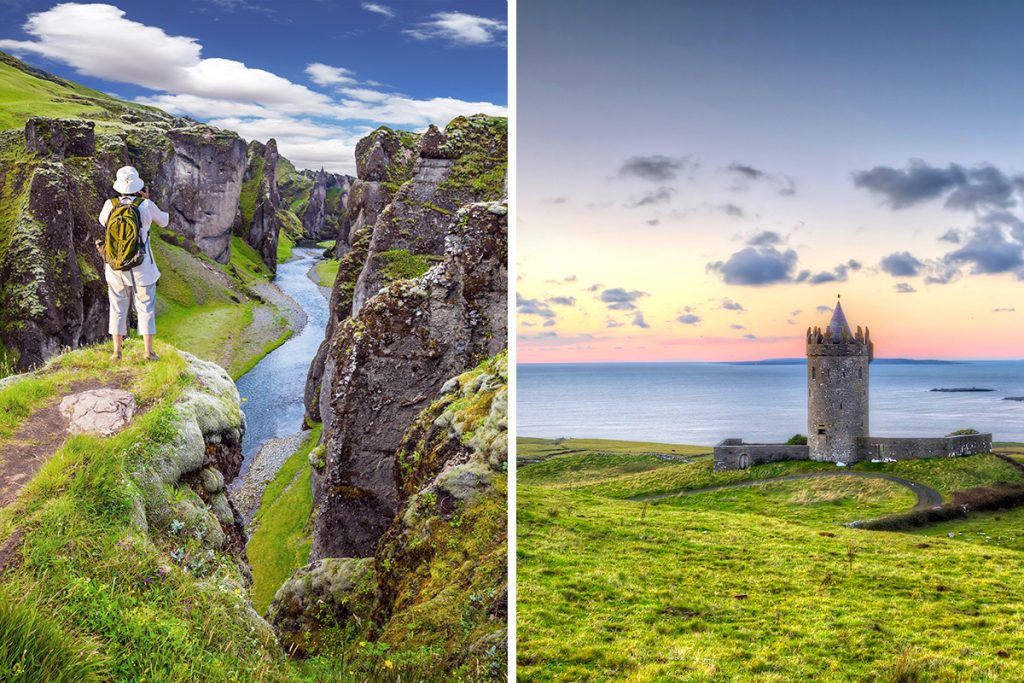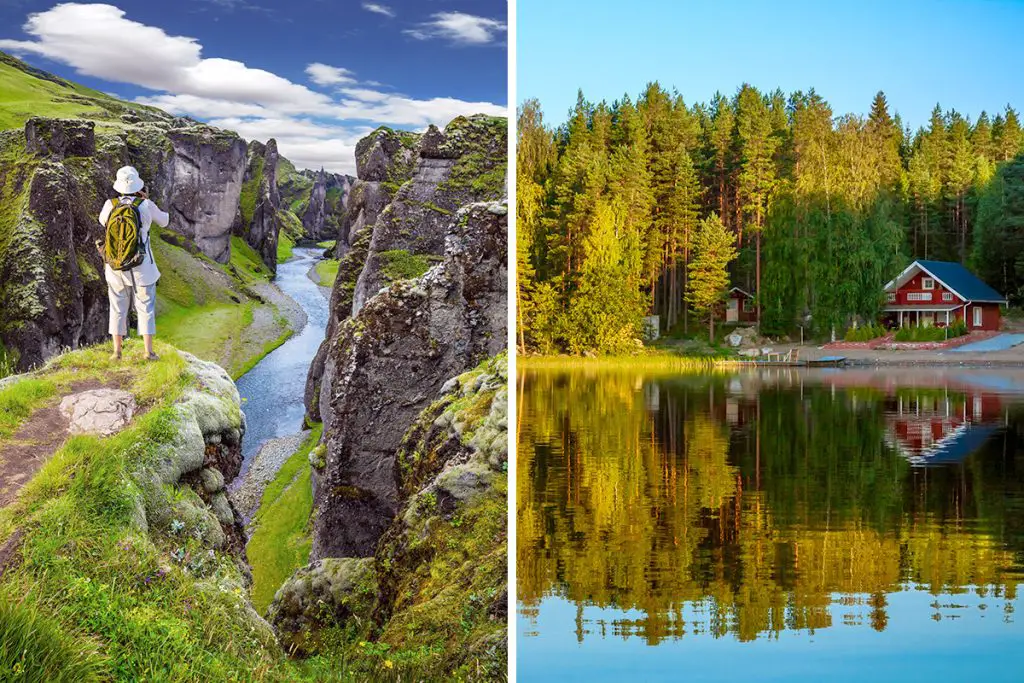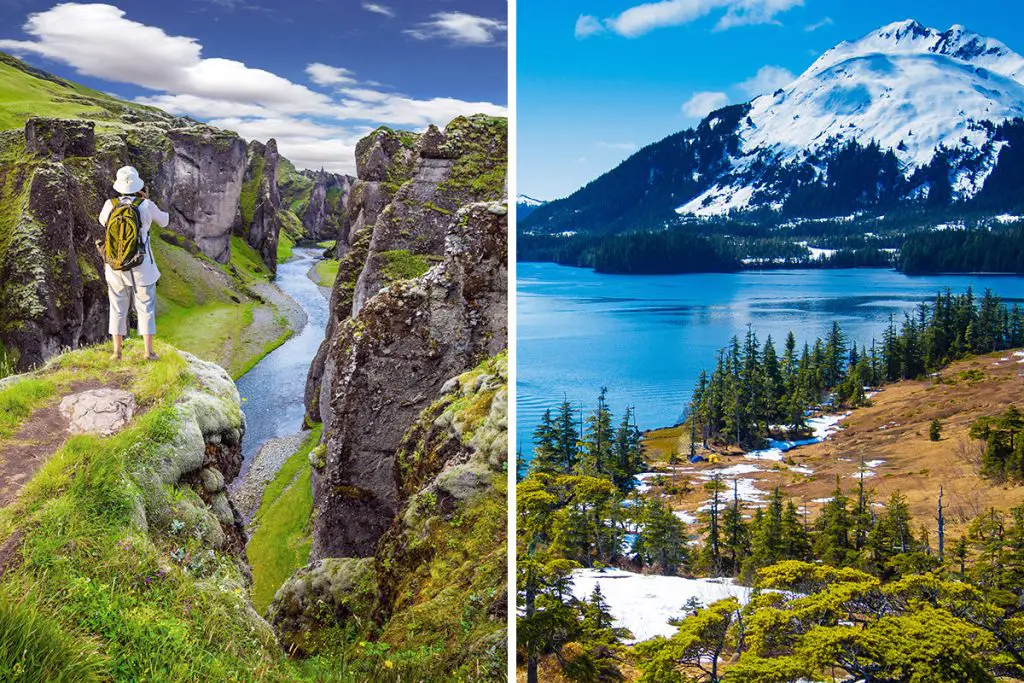You might’ve thought at first that Iceland is a place full of ice sheets and icebergs. But the truth is that Iceland is home to more than a hundred volcanoes. And although there are a number of icebergs and glaciers worth seeing, they won’t captivate you as much as the country’s ice caves do.
Greenland, on the other hand, is much colder than Iceland. It also boasts a ton of wildlife, like polar bears and walruses which you also won’t see as often in Iceland. Greenland also has the largest national park in the world and a lot of dramatic landscapes for sightseeing or hiking.
Between Iceland and Greenland, which is better? Your next vacation depends on whether you’re after unforgettable adventures or unique experiences.
To give you a quick peek into this guide, here’s something to remember. Iceland is green, and Greenland is ice.
Iceland
If you’re looking for scenic road trips, lush green landscapes, and a hot spring wonderland, Iceland is for you. Plus, there are more options in Iceland when it comes to accommodations and restaurants. So, from a price standpoint, you’re getting a lot of value when you visit Iceland.
You may have also been surprised to hear that Iceland is known for its lush green landscapes. Well, only 11% of Iceland’s total land area is covered in ice.
Not to mention, a lot of Iceland’s landscape is home to volcanoes and geothermal hot springs/baths.
That’s not all.
Iceland has waterfalls, some of which freeze during the winter, and even otherworldly topography. The nature you see in Iceland isn’t quite what you’d envision a field of roses or a forest of trees to be.
Instead, the best way to describe it, and as have others described it, is otherworldly.
Put it this way. A lot of movies were filmed in Iceland precisely because of the country’s unique topography. Specifically, this refers to sci-fi, dystopian, and outer space movies. As a matter of fact, Game of Thrones was even filmed in Iceland several times too.
There are a lot of reasons why you should visit Iceland. But rather than overwhelm you with everything it has to offer, here are the golden attractions of what makes the country worth your money.
What Makes Iceland Unique?
The Arctic Circle and South Coast Road Trips
Road trips in Iceland are one of the most unforgettable experiences in the world. All it takes is a single day and you’ll already cover a ton in your Iceland itinerary.
Throughout the trip, you’ll be able to stop by volcanoes, waterfalls, black-sand beaches, and geysers. It also saves you a ton of cash spending for an organized tour.
Between the two routes, the Arctic Circle leans more towards off-the-beaten-path experiences. At one point, it was even hailed as Europe’s Top Destinations in 2019.
In the Arctic Circle route, you’ll also get the chance to learn more about Iceland’s past. One of the most awe-inspiring attractions is the Arctic Henge, a massive sun calendar rooted in Norse mythology.
The Vatnsnes Peninsula is also one of the most raved-about attractions along the Arctic Circle route. A common saying you’ll hear often is that the Vatnsnes Peninsula is where the ocean meets the sky. Truly a marvelous sight.
The South Coast route, in contrast, is more of natural beauty. Think waterfalls, parks, glacier lagoons, cliffs, canyons, nature reserves, and black-sand beaches.
One worth mentioning is the Seljalandoss waterfall, which allows explorers to walk behind it. Another is the Vatnajokull National Park. Here, you can spend hours admiring the view.
For adventure seekers, you can also explore the park’s rivers, ice caves, glaciers, and volcanoes. Take note, though. The Vatnajokull National Park makes up 14% of the entire country’s landmass. So, be prepared to do a ton of walking.
Both the Arctic Circle and South Coast routes are highlights of spending your vacation in Iceland. While you do have the option to do a tour, renting a car might also be cheaper. At the same time, you can explore at your own pace.
So, if you feel like you want to spend more time in certain stops, renting a car offers that flexibility. Although, a 4×4 is recommended if you’re taking the Arctic Circle route.
All in all, a single road trip already covers more than 10 of Iceland’s attractions. Combined, you’re looking at roughly 30 attractions in total. That’s a world-class road trip for you right there. Although many choose to do each route within 1 or 2 days, you’re more than welcome to do it at your own pace if you rent a car.
Iceland Is Home to Several Beautiful Spaces of Natural Beauty
Iceland’s highlands, glaciers, and waterfalls are evidence of the country’s astonishing natural beauty. However, the highlands make up most of the country’s interior.
What can you do in the Icelandic highlands? Everything you could possibly want in a restful and recharging vacation, except sleep. Iceland’s highlands are often referred to as the heart of Iceland, and it’s not hard to see why. Along its miles of rugged terrain, there are no signposts, no shops, zero crowds, and no noise.
The point of exploring Iceland’s many highlands is to connect with nature, natural beauty, and serenity, as is with the country’s waterfalls and black-sand beaches.
You’ll never get tired of being able to see majestic waterfalls wherever you are in the world. In Iceland, Dettifoss, Seljalandsfoss, and Gulfoss are a few of the most popular.
Aside from waterfalls, Iceland’s black-sand beaches are easily just as stunning. Reynisfjara and Djupalonssandur are popular black-sand beaches you’ll hear about often. That being said, make sure you also visit Diamond Beach.
Unlike Reynisfjara and Djupalonssandur, Diamond Beach isn’t known for its landscape. Instead, it’s the little details about Diamond Beach that make it worth a visit. Specifically, the ice diamonds that float onto the shore year-round.
From afar, Diamond Beach appears as a black beach with a field of diamonds. Instagram-worthy enough for you? The famous Diamond Beach is undoubtedly worth more than a glance.
Lastly, glaciers. It should come as no surprise that one of the main highlights of visiting Iceland is being able to see gigantic glaciers. The Breiadamerkurjokull glacier offers a land of wildlife and ice. Whereas the Vatnajokull glacier is the largest in the country, covering most of the central and southern highlands.
The Motherlode of Volcanic Experiences
Iceland isn’t called the Land of Ice and Fire because the name sounds nice. It is in fact, the reality of the country’s landscape. With glaciers on one end and volcanoes on the other, Iceland is home to polar opposites that make it such an intriguing place to visit.
Speaking of volcanoes, how many does Iceland have in total? 130 volcanoes, with about 32 out of the 130 being active.
Visiting all 130 volcanoes though costs too much time and money. Unless you love volcanic expeditions so much that you’d make time to visit all. However, if you’re short on time or want a thrilling experience, there are several you should visit without question.
Thrihnukagigur is the only volcano in the world where tourists are allowed to go inside. Tourists take a mining elevator and descend several feet into a magma chamber where the exploration journey begins.
If Thrihnukagigur wasn’t thrilling enough for you, perhaps the gateway to Hell will be enough. Hekla is one of Iceland’s most famous volcanoes. As the lore goes, Hekla is the portal where souls go to the afterlife.
A cant-miss Iceland volcano is Katla, famous for where Star Wars: Rogue One was filmed. But beyond Hollywood movies, visiting Katla also gives you the chance to tour its ice caves.
Finally, Askja. Those after adventure and a pleasing bath will find nothing better than in this volcano. Because Askja is also a hot spring volcano where tourists can bathe in its steamy, refreshing waters. However, it’s only available from May to September.
Iceland has plenty of volcanoes to explore, each with its own unique landscape, terrain, and experience. You could spend a week touring all the volcanoes around the country and never get bored. But, of course, a change of pace and scenery is always healthy, which leads to the next part of this section.
The Golden Circle
If you won a free trip to Iceland and could pick one tour to do, it would have to be the Golden Circle. There is no perfect or absolute way to define an experience like the Golden Circle. And that’s because many will say it will be the most beautiful trip you’ll ever take in the world.
Hard to believe? That’s what a lot said at first too.
The Golden Circle is a 300 km (186 mi) journey that starts in Iceland’s capital, Reykjavik. Before the tour, it’s worth taking the time to explore the capital as well. Iceland’s architecture is worth snapping photos of, and the city itself is beautiful.
From Reykjavik, your first stop is the Thingvellir national park. More than simply a historic site, Thingvellir is the place where the impossible becomes possible. Because the experience here is being able to walk between two continents, also called the Almannagja Jorge.
This national park is vast and filled with an abundance of waterfalls, geysers, and natural beauty. After Thingvellir, your next stop will most likely be the geyser at Haukadalur. It only erupts a few times every year and is a spectacle you don’t want to miss.
From Haukadalur is your final stop: the Gullfoss waterfall.
You might be thinking, wait…it’s just a waterfall. What could be so special about it? The difference between Gulfoss waterfall among others in the world is that it’s also called the rainbow-making waterfall.
The phenomenon is in itself a natural wonder. And once you see Gulfoss for yourself, you’ll have crossed out your entire bucket list of waterfall experiences.
Volcanoes, unforgettable scenic road trips, natural wonders, and the Golden Circle. While all of these may have already convinced you Iceland is worth the visit, take note there’s even more to see and do.
But don’t decide on Iceland just yet. There’s still Greenland, which is honestly just as impressive.
Greenland
If Iceland is the Land of Ice and Fire, Greenland is mostly ice. As in approximately 80%. So yes, Greenland is going to be one of the coldest places to vacation in. But at the same time, it’s also rich with unforgettable experiences.
Once you’ve been to Greenland, the experiences will be forever etched into your memory and heart. That’s how amazing the place is.
So what can you expect from the Land of Ice? There’s plenty to mention, but also too many to say all in just one guide.
But if there’s one experience you should try at least once in your life? It’s got to be camping on the Greenlandic ice cap. Camping may not be your kind of hobby, but it doesn’t have to be to enjoy this once-in-a-lifetime experience.
Why camp anyway? Simple. To see the Northern Lights. For those who have already seen the dancing lights in Norway, Sweden, or even Iceland, Greenland tops the charts.
You don’t visit Greenland to relax and pamper yourself in 5-star hotels or bathe in hot spring waters. You visit Greenland for the heaps of adventures it offers.
Whether it’s kayaking through fjords of ice, dogsledding, a daring walk on an ice sheet, and more. Noteworthy experiences in Greenland also include cultural experiences and Viking history.
You’ll even get an up-close look at a massive chunk of ice cracking and falling into the ocean.
Curious as to what makes Greenland such a prized country to visit? Here are four that just might make you want to book a flight this instant.
What Makes Greenland Unique?
Everything From Getting Around to Attractions Is an Adventure
You’ve heard it before, and you’ll hear it again. Greenland is not for the faint-hearted. And what that means is, the country is practically adventure on steroids. So much so that Greenland doesn’t have a lot of roads to travel on. It’s common to find that no two towns in Greenland aren’t connected either.
How do you get around then? Mostly by boat or dogsledding. Walking is an option too, and occasionally, riding a helicopter. But that’s only available in areas where it’s legal to do so and if you’re willing to spend the big bucks.
For the most part, you’ll be riding a dogsled 90% of the time during winter. Adventure indeed, right?
Aside from all the walking and dogsledding you’ll do, adventure in Greenland also means seeing icebergs. Tons and tons of ice sheets, icebergs, and humongous glaciers.
The Sermeq Kujalleq glacier is one that you don’t want to miss. Another unforgettable sight is the Ilulissat Icefjord, also a UNESCO World Heritage site.
Other adventurous activities you can do in Iceland include the following:
- Diving
- Skiing
- Kayaking
- Snowmobiling
If you want soft adventure, fishing is a good option too. And for those willing to take a challenge, glacier hiking.
The Arctic Circle Trail
The Arctic Circle trail is reserved for only experienced hikers and backpackers. The trail extends for 100 miles (160 kilometers) and in total, takes about 9 to 11 days to complete.
But that’s not the only reason why it’s reserved for only experienced hikers. The trail has no shops or towns. That means it’s just you, nature, and your backpacking/hiking skills.
So why take the trail to begin with? For many, it’s to reconnect with yourself and it could even count as a spiritual pilgrimage or journey through Greenland’s backcountry.
The other reason? Because it’s also popular for being one of the best long-distance hikes in the world. In fact, you could compare all the beauty you’d see on this hike to what you’d find on Iceland’s Golden Circle Tour.
Hiking along the Arctic Circle Trail also gives you the chance to also spot a ton of wildlife. Some of which include caribou, musk oxen, and foxes.
All in all, hiking the Arctic Circle Trail will make you feel just how big and expansive the world is. You’ll see ice caps and glaciers with sizes taller than skyscrapers and a rugged wilderness that is also inspiring.
Finally, take note that the hiking season here only runs from June to August. Because after all, it would be terrifying to do an 11-day hike in Greenland during winter.
Fly Sightseeing
Considering that Greenland has very few roads, a sightseeing flight feels totally right. This option is especially better for those who don’t prefer to do a lot of hiking or walking.
Plus, you get to see the entire mass of landscapes from the air. It’s a totally unique experience that allows you to get the most bang for your buck if you plan to cover a lot on your itinerary.
There’s also one thing worth mentioning about fly sightseeing that makes it so unique. And it’s that there are certain places you can only see and explore by flying than walking. Take the edge of the Ice Cap, for example.
When you’re looking from the ground, it’s a totally different experience seeing it hundreds of feet in the air.
Here’s where it gets even better.
Fly sightseeing in Greenland is such a popular option that you can choose from varied packages. Each package allows you to see different areas of Iceland. So if you want to focus solely on wildlife, there’s a wilderness adventure to explore in West Greenland.
Prefer to see Greenland’s icy side? There’s a package specifically for that too. And just in case you want to set your own itinerary, you can do that too.
Ilulissat Icefjord and Tasermiut Fjord
The last thing you might expect about Greenland is its fjords, but it is in fact what also put it on the map. The Ilulissat Icefjord has been around for 4,000 years. It’s also the most active glacier in the world, plus it’s a UNESCO World Heritage site.
For many, seeing the Ilulissat Icefjord is one of their most unforgettable experiences. It’s not enough to say that it’s simply beautiful. Should you decide to stay in the town of Ilulissat, you can even see it from several miles away.
However, Greenland has one more fjord worth raving over. And that’s Tasermiut fjord, which also bears the name Arctic Patagonia. It’s also known as a “Big Wall Playground.”
The view here is absolutely stunning and the rock faces in Tasermiut fjord add to its majestic landscape. Not to mention, there’s a natural hot spring just close by that’s perfect for bathing in after a day’s adventure.
Both Ilulissat Icefjord and Tasermiut fjord aren’t just landscapes you can explore on foot. One of the best ways to go about it? Kayaking. And of course, you can also do a sightseeing flight tour if you want a clearer capture of the entire landscape.
If seeing fjords and natural beauty are high priorities for you, head to East Greenland. This is one of the most remote areas in Greenland, but it’s also where you’ll find mountains of beautiful landscapes. In addition, the flower meadows and several scenic backdrop opportunities make it well worth the visit.
Is Iceland or Greenland Better to Visit?
Iceland may be better suited to tourists looking for an all-around vacation. Whereas Greenland is perfect for those that want to get the most out of every second of their day.
In short, Greenland is better for adventure seekers, while Iceland fits those who want varied experiences.
This isn’t to say though that Iceland doesn’t offer adventure. Imagine being surrounded by volcanoes, waterfalls, national parks, and an abundance of landscapes. These would appeal to any outdoorsy traveler.
But also, the term “varied experiences” means you can opt for quiet experiences to relax, unwind, and recharge. Whether it’s quiet walks along black-sand beaches or bathing in hot springs, Iceland has a lot to offer tourists.
In addition, Reykjavik offers plenty for tourists to enjoy. The capital is home to a lot of great local cuisine, beautiful architecture, and exciting nightlife. In fact, did you know Iceland is big on breweries and bars?
That means you have a lot of options whether you’re in need of a chill drinking session or a fun night.
Now, what about Greenland?
In contrast, the country doesn’t offer as many places to recharge. Because really, Greenland favors the brave, bold, and adventurous.
A good example is the Arctic Circle Trail. Hiking through a vast land of wilderness for up to 11 days total is the definition of adventure. And then there’s dogsledding, which is the most common form of transport in Greenland.
Make no mistake, though. Greenland’s landscape is awe-inspiring and beautiful. But it’s clear that it’s also not for everyone. Plus, it’s cold and icy so those who prefer a warmer climate for their vacation might not find Greenland as enjoyable.
Safe to say, most of Greenland’s landscapes are unspoiled. And with 80% of the country in ice, there are quite a number of areas that are impossible to reside in too.
Compared to Iceland, Greenland has a much quieter social life. The capital of Nuuk is where you’ll find all the opportunities to mingle, make friends, and socialize.
Overall, choosing between the two depends on your travel preferences and personality. For adventurous souls, Greenland may be in their favor more. But if you want a mix of adventure and restful experiences, Iceland is the better choice.
FAQ
Iceland vs. Greenland Weather
Both Iceland and Greenland have similar climates and weather during the summer. You could easily characterize them as both having mild weather. However, the most noticeable difference in weather between the two happens during winter.
To sum up the differences in a few words, Greenland has a harsher winter than Iceland. Although, Iceland is windier and sees more rainfall throughout the year. The southern areas of Iceland generally see more rain throughout the year.
Whereas in Greenland, the air is dry and heavy rain is quite rare. In fact, Northeast Greenland is often referred to as the Arctic desert. Mainly because less rainfall occurs in this part of Greenland compared to the Sahara.
The mildest temperature you’ll experience in Greenland sits just below 50°F (10°C). There are instances, though, where the temperature rises to 68°F (20°C). While in Iceland, the temperature is warmer – around 54°F (12°C). Note that these temperatures are the average weather in summer and during the months of June, July, and August.
As soon as winter hits, expect below-freezing temperatures.
Is Greenland Colder Than Iceland?
Greenland is a lot colder than Iceland. During the coldest months of the year, Iceland’s temperatures typically drop to 32°F (0°C) and sometimes, lower.
In Greenland, temperatures drop to 1.4°F (- 17°C). The coldest that Greenland has ever been is -11.2°F (-24°C).
Why Is Iceland Warmer Than Greenland?
Iceland is warmer than Greenland for two reasons. The Land of Ice and Fire should give you a hint.
First, the Gulf Stream which flows to the southern and western parts of Iceland carries warmth from the Caribbean. This means it’s thanks to the Gulf Stream bringing warm air that it’s able to balance the cold air in the Arctic.
Second, Iceland sits on one of Earth’s hotspots, the Mid-Atlantic Ridge. Generally, a hotspot is a region located deep within Earth’s mantle and releases heat constantly through convection.
One of the major reasons why Iceland sees so much volcanic activity is precisely due to its geography. If not for Iceland being situated on a hotspot, you most likely won’t see as much volcanic activity in the area.
Is Iceland Greener Than Greenland?
Iceland is greener than Greenland, although many wouldn’t have thought this to be the case. If you pull up a satellite image of both countries, you’d see more green in Iceland no doubt.
Why Is Greenland Icy and Iceland Green?
The reason why Greenland is icy and Iceland is green has mostly to do with each country’s climate. Iceland’s weather is warmer, and its sea surface temperatures are on average 10° F (6°C) warmer.
Milder climates translate to longer growing seasons. And in Iceland’s case, that’s exactly what happens in the summer.
In addition, only about 11% of Iceland is covered in ice. Whereas in Greenland, you’re looking at 80% of it being covered in ice. Greenland doesn’t have the help of the Gulf Stream either to bring in warm air and provide as much warmth to the region.
Because Greenland is a lot colder year-round, this highly contributes to its landscape and topography. As expected, there’s no question that Greenland’s climate gives rise to a larger number of glaciers and ice sheets.
What Continent Is Iceland and Greenland?
Iceland is located in the continent of Europe, while Greenland is located in the continent of North America.
Where Is Iceland and Greenland?
Both Iceland and Greenland are located between the Atlantic and Arctic Ocean. Geographically, Greenland is part of North America, while Iceland is part of Europe. The Denmark Strait is also what separates Iceland from Greenland.
Is Iceland and Greenland the Same?
Iceland and Greenland are two very different places. Although both share a few similarities, there are major differences between the two countries.
For one, the landscape of Iceland is very different from what you’d find in Greenland. Greenland is mostly ice, while Iceland is greener. Even the climate, culture, language, and history are different.
If Iceland is famous for its volcanoes, Greenland is famous for its glaciers and ice sheets. Or, you can think of it this way.
Greenland leans more towards vast, open spaces and snow. Whereas Iceland has a lot of natural beauty and milder temperatures.
Getting around is also one of the most noticeable differences between the two. Iceland has more roads, offering tourists easier accessibility from one town to the other.
Greenland, on the other hand, has fewer roads so getting around isn’t as easy. You’ll also find more arctic wildlife in Greenland than in Iceland.
Something worth mentioning is also the price. Iceland is roughly 10% cheaper than Greenland. Food, accommodations, and even transport are cheaper. In fact, it’s easier to get to Iceland because it’s linked to several European and North American cities.
As you can see, there are a lot of differences that prove how different Iceland is from Greenland.
Is Greenland Part of Iceland?
Greenland is not part of Iceland and is a self-governing country. However, Greenland is part of the Kingdom of Denmark. Iceland was originally part of Denmark as well but became an independent republic in 1944.
Iceland to Greenland Distance
The distance between Iceland and Greenland is 752.5 miles or 1,211 kilometers.
Shortest Distance From Iceland to Greenland
The shortest distance from Iceland to Greenland is 730.2 miles or 1,175.1 kilometers. Take note, though, that this is the air travel distance between the two.
Can You See Greenland From Iceland?
It’s not possible to see Greenland from Iceland, and there’s a good explanation as to why. The human eye can only see up to 3 miles (5 km) on flat ground. If you’re standing in a place with a higher elevation, it’s possible to see hundreds of miles.
Take note that the distance between Iceland and Greenland is 752.5 miles (1,211 km). If you’re not in the westernmost part of Iceland, that distance is even farther away.
So even if you could see hundreds of miles at a higher elevation, being able to see 752 miles is a far stretch. Iceland’s highest peak, Hvannadalshnúkur, measures 2,110 meters (6,920 feet). Even with that much elevation, you’d only be able to see about 121.17 miles (195 km).
Theoretically, if Mount Everest were in Iceland, it still wouldn’t be possible. Mount Everest measures 8,849 meters (29,031.70 feet). Even if you were standing on Mount Everest’s summit, you’d be able to see 208.8 miles (336 km).
As impressive as that distance is, it still doesn’t cover half the distance between Iceland and Greenland.
Which Is Bigger – Iceland or Greenland?
Greenland is about 20x bigger than Iceland. Greenland has a total land area of 836,297.28 square miles (2,166,000 square kilometers). Iceland, in contrast, has a total land area of 39,768.52 square miles (103,000 square kilometers).
Iceland is also the 108th largest country in the world, while Greenland ranks as the 12th largest. These numbers clearly prove that Greenland is much larger than Iceland.
Iceland vs. Greenland Population
Population is one of the most significant differences between Iceland and Greenland. Despite being 20x larger, Greenland only has a total population of 56,000. Whereas Iceland has a total population of 365,000.
This is also because 80% of Greenland is covered in ice, making it hard for a lot to live in the country. Although both Iceland and Greenland are sparsely populated, Greenland ranks as the world’s sparsest.
About 17,000 to 19,000 of Greenland’s citizens reside in the capital, Nuuk. There are a few areas outside of the capital where you can reside in too, but mostly, the majority of Greenland is uninhabitable.
Who Owns Iceland and Greenland?
Greenland is owned by Denmark, whereas Iceland is an independent nation. At one point, Iceland was part of Denmark from 1814 to 1918. From 1918 to 1939, Iceland became a separate kingdom but was still part of Denmark by law.
It wasn’t until 1940 that Iceland became its own independent nation. Some might also say that Europe owns Iceland but that’s not exactly true.
Iceland is part of the European Economic Agreement, but not the European Union. This only means that the travel and trade relationships between Iceland and Europe are strong. At the same time, it also means that Iceland is not a European country nor is it bound by all European laws.
Who Named Iceland and Greenland?
The names “Iceland” and “Greenland” were named by its original settlers, the Vikings. But before the name “Iceland” came to be, it was originally called “Snowland.”
Why Is Greenland Called Greenland and Iceland Called Iceland?
To understand how the names “Greenland” and “Iceland” came to be, you have to learn a small amount of Viking history.
For Vikings, naming conventions are based on the first thing they see.
The first settler, Naddaddor, was the first Viking to set foot on the island, according to National Geographic. Because the land was entirely covered in snow, Naddaddor named it Snaeland, which translates to Snowland.
According to the lore, one of the Vikings climbed a mountain in frustration with his daughter’s passing. Upon reaching the summit, he saw icebergs and gave the land a new name, “Iceland.”
Greenland is a different story. The first Vikings to settle in Greenland happened in the 10th century. During this time, Greenland wasn’t as cold or icy as it was. Erik the Red was the first Viking to ever set food on the island.
The lore states that Erik the Red gave the island the name “Greenland” to attract settlers. The name was to imply that “Greenland” was more fertile than what was seen in reality.
However, historical archives also reveal that Greenland wasn’t the icy landscape it is today. During the 10th century, Greenland had a lot of green and was in fact, quite fertile. This may also be another reason why Greenland is called “Greenland.”
How to Get From Iceland to Greenland
You can only travel from Iceland to Greenland in two ways: by plane and cruise ship. Traveling via plane is the best and most popular option. Only two airlines currently offer regular flights to Greenland from Iceland: Air Greenland and Air Iceland.
Air Greenland operates two plane routes: the Copenhagen–Greenland route and the Reykjavik–Greenland route. Air Iceland operates only one plane route: Reykjavik–Greenland.
As of this writing, there are no direct flights from the US. However, there are several operating flights from the US to Reykjavik, Iceland’s capital.
So, if you’re traveling via plane, your best option is to fly to Reykjavik and then to Greenland via Iceland Air.
If you don’t want to travel by plane, your only next best option is via a cruise ship.
There are several cruise lines that offer Greenland as part of the cruise itinerary. Royal Caribbean is one cruise line that offers this service.
Ferry to Greenland From Iceland
There are no ferries that take you from Iceland to Greenland. Currently, the only way to get to Greenland via ferry is through a trans-Atlantic cruise that includes Greenland as a stop.
Iceland to Greenland Ferry Time
There is no ferry that takes you from Iceland to Greenland as of this writing.
Iceland to Greenland by Boat
Getting to Greenland from Iceland by boat is not possible at this time.
How Far Is Iceland From Greenland by Boat?
Iceland is about 1,100 miles (1,770.3 km) away from Greenland via boat. The voyage could take up to four or five days, assuming a continuous sail.
Greenland Day Trip From Iceland
If you plan to take a day trip from Iceland to Greenland, your best option is to travel via plane. The average flight time from Iceland to Greenland takes approximately 3 hours and 20 minutes.
Take note that Air Greenland and Air Iceland offer direct routes from Reykjavik to Greenland’s capital, Nuuk.

